Spruce Run Reservoir is the third largest reservoir in New Jersey and one of the oldest. Completed in 1965, the 6,000-foot-long earthen dam holds back eleven billion gallons of water over an area that covers 1,290 acres enveloped by fifteen miles of jagged shoreline. In addition to its role as a principal water source, the impoundment and the surrounding Recreation Area, operated by the New Jersey Division of Parks and Forestry, create an arena for outdoor enthusiasts of all kinds. Wade in the inviting waters of the beach and feel the sand between your toes. Scour the shoreline with rod and reel in pursuit of trout, largemouth bass, black bass, northern pike, catfish, carp, or yellow perch. Watch shorebirds hover overhead as you skim across the water's surface in sailboat or kayak. Walk leisurely rustic trails or hike a narrow path of the Highlands Trail that winds through the park. Camp overnight on a sandy peninsula or admire unspoiled vistas from a picnic area. The New Jersey Division of Fish and Wildlife also maintains the 2,000-acre Clinton Wildlife Management Area, an undeveloped oasis of croplands, fields, and forest surrounding most of the reservoir. Suitable for exploration, public activities include bird watching, nature study, photography, hiking, and hunting in season. Also suitable for exploration is the reservoir's source!
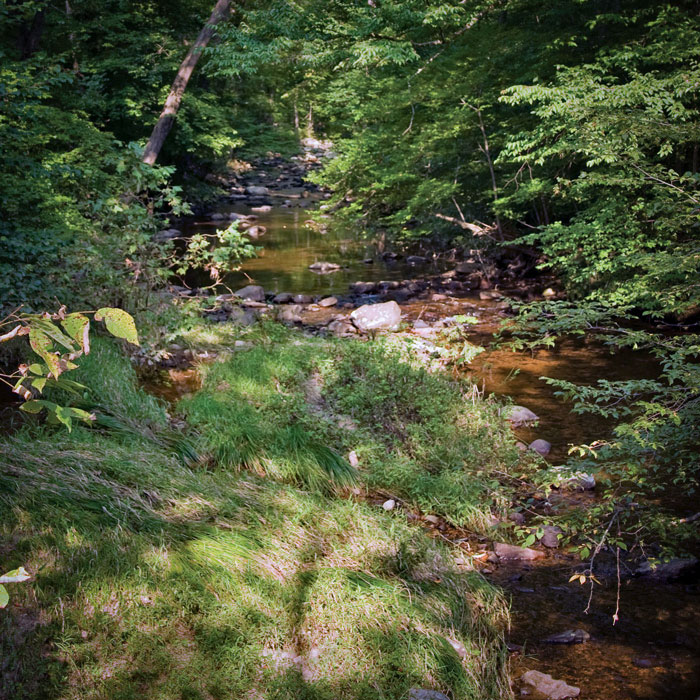
The reservoir is named for the mountain stream that feeds it. Spruce Run Creek is a sparkling ribbon of natural beauty whose course through rich agricultural land interspersed with hardwood and evergreen forests still embodies the area's early history and provides sanctuary for many species of wildlife. The spring rises along the ridge of Schooley's Mountain, ten miles northeast of the reservoir near the boundary of Washington Township, in Morris County, and Lebanon Township, in Hunterdon County. In 2004, an alliance of several state and local organizations undertook ambitious preservation efforts to save almost 300 acres of open space along the ridge. The site's principle manager, the Hunterdon County Department of Parks and Recreation, planted native grasses to encourage wildlife habitat.
These stewardship efforts were preceded by those of the property's previous owners, Adam and Germaine Roth. Adam Roth immigrated to the United States from Germany in 1923 and made his mark in Detroit with patented modifications to the automotive piston engine in 1936. By 1943 Roth found himself married and living in Glen Rock, New Jersey, near his successful aircraft-engineering factory. The following year he and his wife invested their earnings in two Hunterdon County farms that they planned to use primarily as country retreats. There were four residences, several two-story poultry houses, hog pens, a log cabin with a waterwheel that supplied its running water, and a large dairy barn with the capacity for 125 milking cows. Apple, pear, plum, cherry, and peach trees provided additional income. The Roths developed seven man-made ponds for extensive crop irrigation by excavating natural mountain springs that were discovered by their four children. The ponds were stocked with fish, and friends and family frequently gathered around barbeque grills, jumping off the docks. It is from the discovery of the springs that the property was named Crystal Springs Farm, and these ponds represent the headwaters of the Spruce Run Creek.
With the addition of smaller properties over time by the Hunterdon County Department of Parks and Recreation, the preserve now totals 539 acres. To get there, take Pleasant Grove Road from Schooley's Mountain Road to the intersection with Califon Road. Turn left and follow until the road changes its name back again to Pleasant Grove Road. Parking for the Crystal Springs section of the Teetertown Preserve is located on your left. A wooded trail begins across the road, leading around the perimeter of a large field, across the creek and eventually to the farm site. The farm buildings are gone, but visitors can walk the old roads past the ponds and fields full of wildlife. Although unmarked, easier access to the ponds, especially helpful for fishermen, is off Califon Road at Harrow Road. Turn right, and the road leads directly to a picnic area and trails down to several of the old farm ponds.

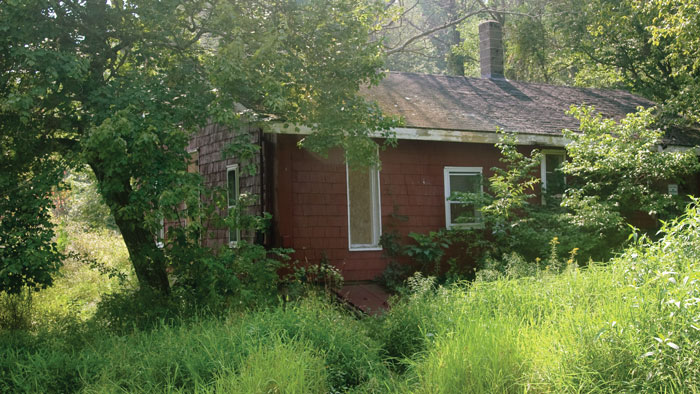
From the Teetertown/Crystal Springs lot, drive a short distance south, make a right turn onto Sharrer Road and then a left onto Anthony Road. Along this winding route, there are more traces of past inhabitants along the Spruce Run. Anthonytown was a small village named after Philip Anthony, an early settler, and consisted of two sawmills, a blacksmith and wheelwright shop, a tannery, a schoolhouse, a general store, a Methodist church, and a post office. Only a few homes remain today.
Make a left turn onto Newport Road and travel less than a mile before arriving at the next Hunterdon County Department of Parks and Recreation outpost. Known as Miquin Woods, this 302-acre county park is a former Boy Scout camp, originally established in 1928 as Camp Watchung. In 1934, Miquin Lodge #68, the Order of the Arrow, was brought to Camp Watchung. The word Miquin is Lenape Indian for feather; the symbol for the lodge was the eagle feather.

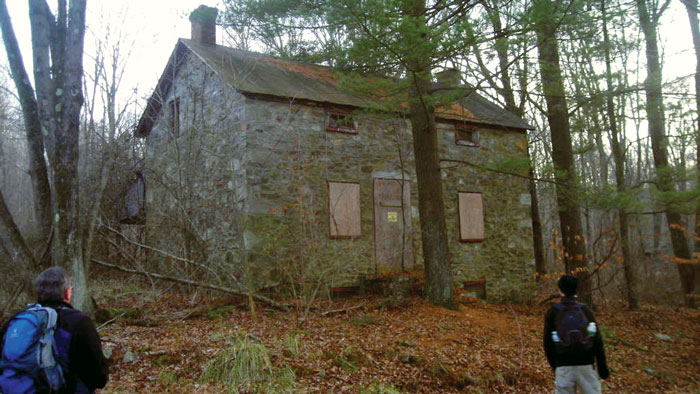
The upper and lower camp were divided by the rock-strewn Spruce Run, and the man-made Craig Pond, fed by the creek, served as the swimming and boating area. A large dining hall, complete with a massive elk's head resting above the mantle of a stone-quarried fireplace, overlooked the pond. Other structures included a trading post, woodland chapel, handicraft lodge, nature lodge, and first aid cottage. Camp Watchung finally closed in 1986, but the land was never developed and the structures fell into disrepair. After the camp was acquired as open space, most of the buildings were demolished except for the stone camp office and springhouse, which stand as quiet sentinels from a different time as visitors enjoy a harmonious blend of scenery for hiking, fishing, and nature study.
Leaving Miquin Woods, turn left onto Newport Road. As you approach a small stone arch bridge over Spruce Run, look to the left of a long gravel road, and you may glimpse the remnants of a stone mill located on private property. Erected in 1865, it was once the business center for a small community of farms known as Apgar's Mills, grinding grain between two sets of interior grinding stones powered by a 21-foot waterwheel. After the stop sign, make a right turn onto Red Mill Road, so named for another of the many mills along Spruce Run that relied on waterpower for the production of flour and other grain products.
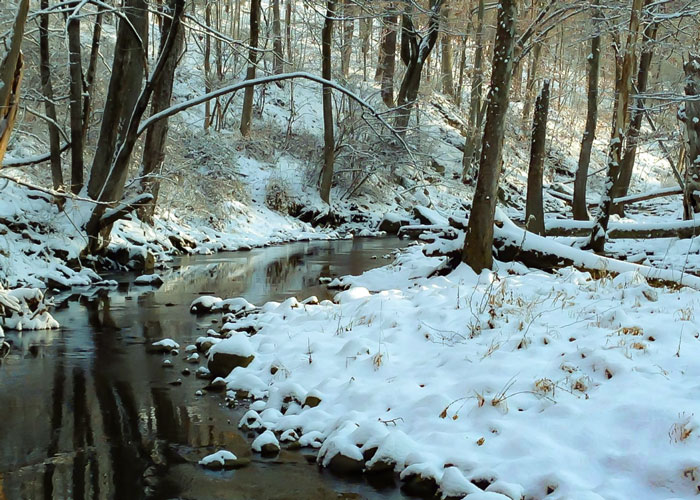
Before approaching another small stone arch bridge about a mile down Red Mill, turn left onto Spruce Run Road and follow it to the end. Spruce Run Cemetery is on the right side and the distinctive conical spires of the beautiful Spruce Run Evangelical Lutheran Church rise straight ahead. Although the present church was erected in 1870, the first congregation gathered for services in 1775 in a log cabin that stood nearby.
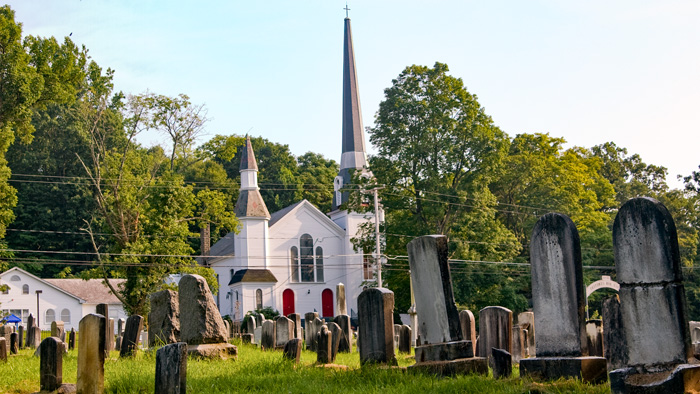
Turn right onto West Hill Road (County Route 628) and follow it into the borough of Glen Gardner, which was built on the power of the little mountain stream. The first mill was built in 1760, followed by another downstream in 1835 whose owner conceived the idea of starting a factory that manufactured picture frames. In 1863, five enterprising brothers named William, John, George, Oliver, and Joseph Gardner relocated from New York City and soon employed 700 craftsmen making picture frames and chair seats. In 1871, the town that sits between two mountains named itself Glen Gardner in honor of the brothers. The town's industrial era ended when the brothers moved away and the factory burned down.

A one-lane bridge spans Spruce Run on School Street. Fabricated in 1870 by William and Charles Cowin of Lambertville, this Pony truss bridge has interior beams sloping diagonally towards the center of the bridge to counteract the weight of vehicles that traverse it. Rehabilitated in 1993, it is listed on the New Jersey and National Registers of Historic Places.
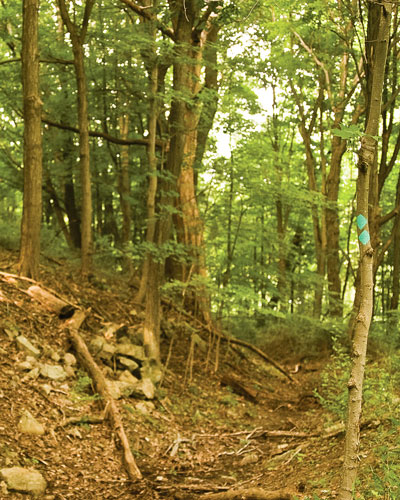
Turn left on State Highway Route 31 and go two miles south to the Van Syckle's Road traffic light. Turn right, over a bridge that spans Spruce Run, and stop at the gravel parking area, where there is easy access for fishing in the stream and reservoir. Across the road is the county-owned Union Furnace Preserve, an undeveloped 100-acre wooded hillside that hosts a section of the Highlands Trail. As you enter the preserve and walk the trail marked with teal, diamond-shaped blazes, you will notice the hard-packed surface of an old millrace, a remnant of the Union Mill, another large gristmill built in the early 1800s.
From 1742 to 1752, two Philadelphians, William Allen and Joseph Turner, acquired 10,849 acres of fields and woodlands for establishing an iron furnace along Spruce Run, an iron forge along the South Branch of the Raritan River near the present-day town of High Bridge, and another furnace east of High Bridge, known collectively as the Union Ironworks. Iron production in the colonies required miners, woodcutters, charcoal makers, fillers, blacksmiths, wheelwrights, and teamsters. Trades associated with the furnaces included farmers, millers, and shopkeepers. The furnace along Spruce Run, Union Furnace, produced 500- 1,000 tons of iron a year for the casting of artillery and farm implements. Fired three times a day and tapped twice a day, temperatures within the stone-laden stack had to reach almost 3,000 degrees to melt iron ore. The forty slaves that lived on the property performed some of the most dangerous work.
Loyal to the English Crown, Allen and Turner fled during the American Revolution, but their young superintendent, Robert Taylor, cast military hardware for the Continental Army until 1781, when the forest were depleted of fuel. Taylor then shifted his attention to Union Forge along the South Branch of the Raritan River and developed one of the largest foundries in the country. In 1811, the 808-acre Union Farm, consisting of abandoned structures, livestock, and slaves, was sold to Hugh Exton, who would build the gristmill along Spruce Run. Following a succession of ownership, Hunterdon County acquired 92 acres of the farm, a large part of today's preserve. Rubble from the Union Furnace was removed during construction of the reservoir.
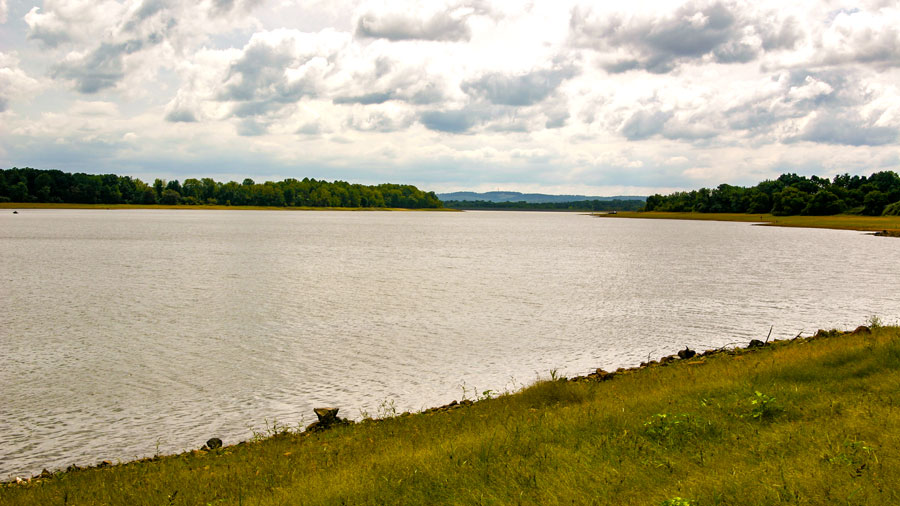
The Elizabethtown Water Company of New Jersey was first drawn to the idea of building a reservoir at the confluence of Spruce Run and Mulhockaway Creek just before 1929. Land speculators bought almost 2,100 acres in anticipation of selling it to the water company, but the Great Depression waylaid everybody's plans. The state acquired 1,500 acres to build a game preserve, and in 1936, the remaining 600 acres went to Lloyd Wescott and his wife Barbara for $70 an acre. After they moved into their red clapboard farmhouse, the Wescotts restored the old farm buildings and built new metal barns. Farm tenants lived close to each of three complexes of cow barns. Lloyd's brother, parents and other relatives lived in other separate homes on the property, which he called Mulhocaway Farm (intentionally spelled differently from the name of the creek.) The Westcotts intended to breed healthy livestock, and when the Hunterdon County Board of Agriculture was introduced to the concept of artificial breeding of dairy cattle, Lloyd proposed to construct housing for Guernsey bulls. The farm's facility became the first artificial insemination station in the country.
In 1956, the State of New Jersey revived the plan for a reservoir in the fertile valley. The Westcotts negotiated a selling price and relocated to another farm in Delaware Township in 1959, considering the move a blessing since the structures and equipment had become obsolete. Theirs was the only farm to be inundated by water from Spruce Run Creek.

Delightful fantasies beyond words! Gold, Platinum & Silver Jewelry, Wildlife Photos, Crystal, Lighthouses. Perfume Bottles, Santas, Witches Balls, Oil Lamps, Paperweights, Chimes, Art Glass, Wishing Stars. Also offering jewelry and watch repair

Artisanal cheeses, wood fired breads, 100% grass-fed beef, whey fed pork, and suckled veal, 100% grass-fed ice cream, pasta made with Emmer wheat and our own free-range eggs, and pesto made with our own basil! Bread and cheesemaking workshops are held on the working farm as well as weekend tours and occasional concerts.